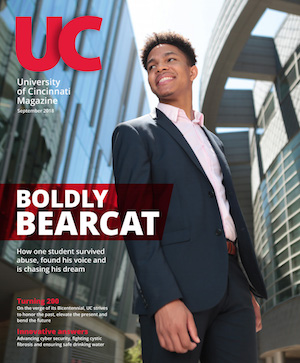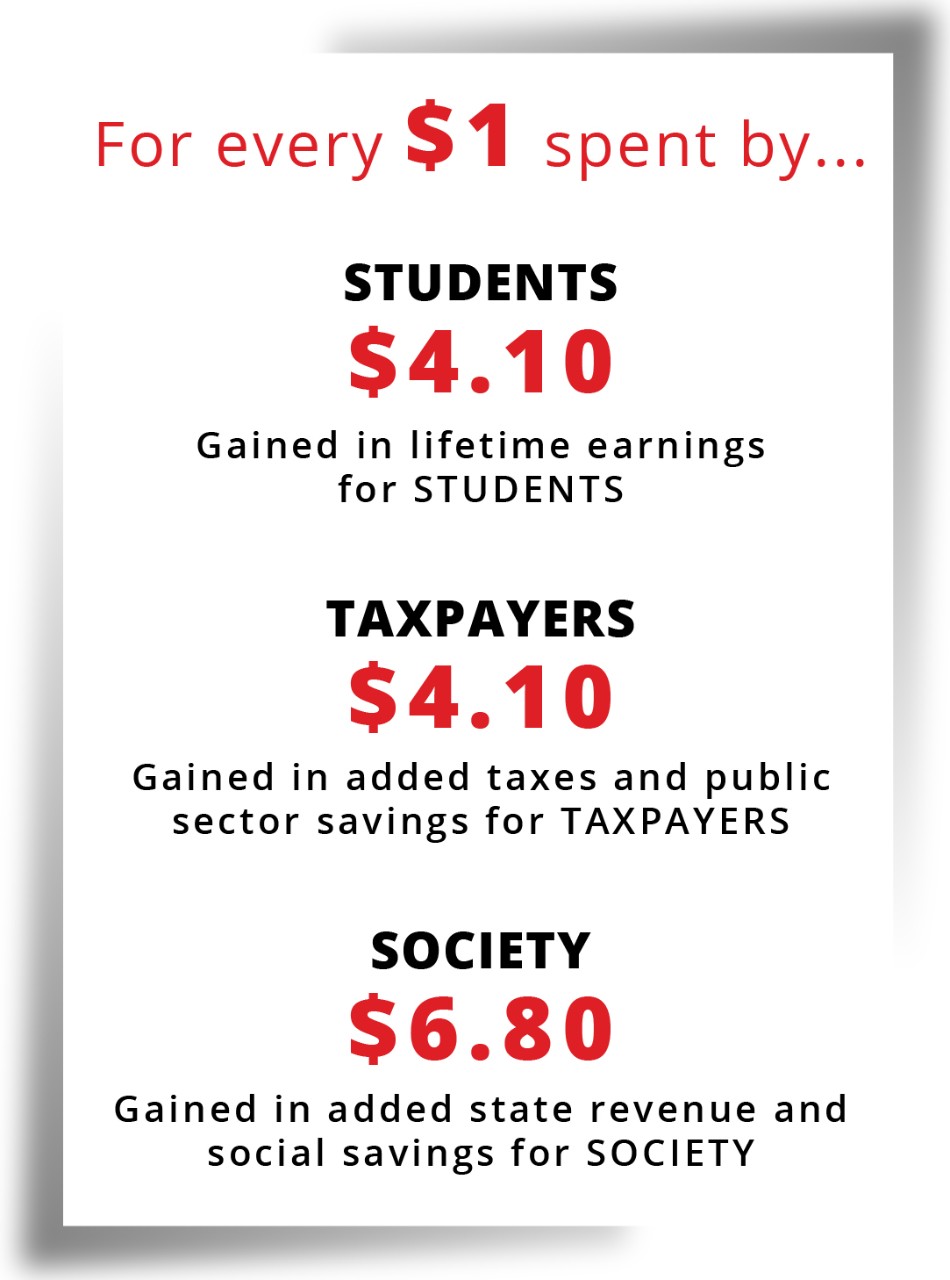UC's $4.2 Billion Regional Economic Impact Supports Nearly 62,000 Jobs
UC serves as an economic powerhouse, adds more than $13 billion to economic base across the state of Ohio.
 September 2018
September 2018
Boldly Bearcat
Finding his voice
Danger in the tap
Virtual defense
Global game changer
Celebrating UC's Bicentennial
 Past Issues
Past IssuesBrowse our archive of UC Magazine past issues.
UC serves as an economic powerhouse, adds more than $13 billion to economic base across the state of Ohio.
By Matt Koesters
513-556-5279
By M.B. Reilly
513-556-1824
June 12, 2018
The University of Cincinnati delivers a significant economic boost to the region and state of Ohio thanks to alumni impact, operations and research spending, student demand for goods and services, launch of start-up companies and more.
A study released today finds that UC’s overall impact on the business community in southwest Ohio, northern Kentucky and eastern Indiana is nearly $4.2 billion ($4,159 billion) in added income to the business community, an amount that supports 61,704 jobs. For perspective, this means that one out of every 22 jobs in the region is supported by the activities of the university and its students.
Statewide, the study found that UC increases the economic base by $13.4 billion.
The UC study, by labor market analytics firm EMSI (Economic Modeling Specialists International), is part of a larger study on the economic impact of Ohio’s public universities commissioned by Ohio’s Inter-University Council. That larger study (see the executive summary) found that the state’s public universities generated a $42 billion economic impact throughout Ohio, supporting a total of 558,841 jobs (which represents one of every 12 jobs in the state). These studies make clear that whether from a student, taxpayer or societal perspective, higher education's return on investment is solid and that Ohio's public universities are substantial drivers of economic activity and creators of economic opportunity.
“With hard facts, this economic impact study reminds us that the University of Cincinnati and Ohio’s other public universities are a significant spark for economic vitality. UC’s greatest impact is through our students, graduates and alumni. But we also fuel immense contributions in research, clinical practice, community engagement, public tax revenue, visitors, and improved quality of life. We are always looking for new and next ways to provide even greater return on investment for our region and state," stated UC President Neville Pinto.
Bruce Johnson, Inter-University Council president, agreed, “Public universities like UC create value in a variety of ways, whether that’s through knowledge creation, helping student increase their career readiness, or assisting the state's industries through workforce education and development. Most importantly, a degree from UC is an excellent investment for students, providing, on average, a 12.4 percent return."
This UC economic impact and return on investment analysis used student and financial data from fiscal year 2017 (July 1, 2016, to June 30, 2017) to examine the university’s impact in southwestern Ohio (Brown, Clermont, Hamilton, Butler and Clinton counties); southeastern Indiana (Dearborn, Franklin and Ohio counties); and northern Kentucky (Boone, Bracken, Campbell, Gallatin, Grant, Kenton and Pendleton counties).
Alumni Impact: $2.8 billion (supporting 34,883 jobs)
The education and training UC provides for regional residents results in the greatest impact. These students enter the workforce with new skills and become employees of Greater Cincinnati businesses. During the analysis year, past and present students of the university generated $2.8 billion in added income for the region – the equivalent of supporting 34,883 jobs. This figure represents the higher earnings that graduates enjoy, increased output by employers hiring these students and graduates, and the multiplier effects as graduates and their employers spent money at other businesses.
Operations Spending: $802.2 million (supporting 9,024 jobs)
As an important employer in the region, UC’s total annual payroll supported 6,758 faculty and staff salaries in fiscal year 2017. Since 92 percent of UC employees lived within the metropolitan area, much of these salaries was spent within the region. UC is also a large-scale buyer of goods and services to cover day-to-day expenses for facilities, professional services and supplies.
Research Spending: $322 million (supporting 4,076 jobs)
UC research activities impact the economy by employment related to research activities and purchasing equipment, supplies and services. Over the last four years, UC has earned 444 invention disclosures, filed 199 new U.S. patent applications and produced 66 licenses.
Student Spending: $109.5 million (supporting 1,867 jobs)
Nearly 50 percent (49 percent) of matriculated students attending UC originate from outside the region, with some relocating to the metropolitan region. These students would not have come to the region if the university did not exist. In addition, a number of in-region students would have left for educational opportunities if not for the existence of the university. While attending UC, these relocated and retained students spend for groceries, rent, transportation and other needs. A significant portion of these expenditures occurred within the region.
Construction Spending: $73.6 million (supporting 947 jobs)
Construction spending had a substantial impact on the region’s economy in fiscal year 2017 as UC commissions contractors to build or help renovate a number of facilities.
Visitor Spending: $24.8 million (supporting 660 jobs)
Thousands of visitors from outside the region attend commencement, sports events, performances and other UC-sponsored events. While in the region, visitors spent money for lodging, food, transportation and more.
Start-Up Company Impact: $18.1 million (supporting 141 jobs)
UC creates an exceptional environment that fosters innovation and entrepreneurship evidenced by the number of UC start-up companies created in the region that license and commercialize UC technology or knowledge.
Clinical Spending: $1.7 million (supporting 10,106 jobs)
UC Medical Center, West Chester Hospital, the Daniel Drake Center for Post-Acute Care and UC Physicians Company are related to and affiliated with UC.
UC's Strategic Direction, Next Lives Here, will enhance the university's impact over the next 10 years.
Student Perspective: Benefit-cost ratio of 4:1
From an individual student’s perspective, for every $1 a UC student invests in the cost for college, he or she will, on average, receive $4.10 in higher future earnings. That means the average annual rate of return for students on their educational investment is 12.4 percent. So, the average bachelor’s degree completer at UC will see an increase in earnings of $26,900 each year compared to someone with a high school diploma working in Ohio. Over a lifetime, that adds up to $1.156 million in higher earnings.
Taxpayer Perspective: Benefit-cost ratio of 4:1
UC generates more in tax revenue than it takes. As UC students earn more, they pay more in taxes. Employers also make higher tax payments as they increase output and purchase more supplies and services. By the end of the worker careers of fiscal year 2017 students, state and local governments will have collected a present value of $941 million in added taxes. UC received $252 million in state and local government support during the analysis year, but total benefits derived from that equal $1 billion. So, for every $1 of public money invested in UC, taxpayers receive a cumulative value of $4.10 over the course of graduates’ working lives. That represents an average annual return of 9 percent.
Social Perspective: Benefit-cost ratio nearly 7:1
The social savings related to improved health and decreased crime and unemployment can be correlated with higher levels of education. Society invested a present value of $2 billion in fiscal year 2017 towards UC and its larger mission. This includes all expenditures by the university, student expenditures, and student opportunity costs. For every $1 of this investment, society as a whole in Ohio will receive a cumulative value of $6.80 in benefits, e.g., avoided medical costs, reduced criminal justice system expenditures, reduced unemployment. These benefits will occur for as long as UC’s fiscal year 2017 students remain employed in the state workforce.


Apply to one of UC’s undergraduate programs or to a UC graduate program.